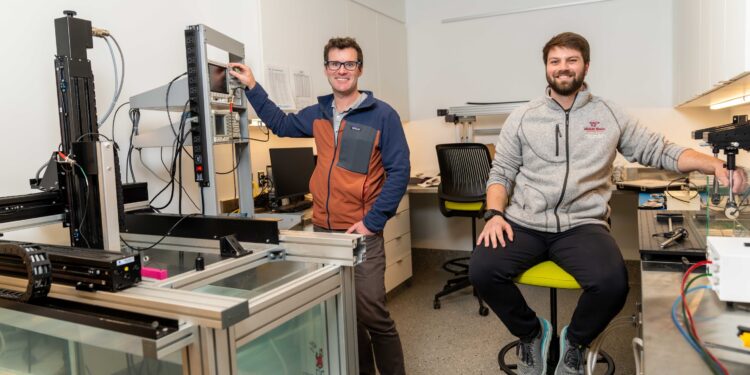Wynn Legon (left), educational director of the MRI-guided transcranial focused ultrasound facility at the Fralin Biomedical Research Institute, and Andrew Strohman, MD-Ph.D. student at Virginia Tech, were among researchers who reported that applying low-intensity focused ultrasound to a deep area of the brain could potentially help people cope with chronic pain. The research was published in the Journal of Neuroscience. Photo by Clayton Metz for Virginia Tech. Credit: Clayton Metz/Virginia Tech
Virginia Tech researchers at VTC’s Fralin Biomedical Research Institute report that applying low-intensity focused ultrasound to an area deep in the brain could pave the way for new ways to help people do facing chronic pain.
In a study published in the Journal of NeuroscienceScientists have demonstrated the effectiveness of using low-intensity focused ultrasound to modulate activity in a critical region of the brain that processes and regulates pain signals.
Researchers, including first author Andrew Strohman, a Virginia Tech MD and PhD student at the Fralin Biomedical Research Institute, found that applying low-intensity ultrasound to a structure known as the dorsal anterior cingulate cortex reduced the pain and decreased bodily responses to pain. and a decrease in pain-related brain activity without the need for invasive procedures, the researchers said.
“This study indicates a non-invasive and effective way to modulate a critical region of the brain involved in pain processing, while eliminating many of the risks associated with surgical procedures,” said Wynn Legon, assistant professor at the Institute of Pain. Fralin biomedical research and senior author of the study. “This provides a potential new means to modulate brain activity in response to pain, which could be used to better understand the mechanisms of chronic pain to provide an innovative new therapeutic option that could change the way we approach and treat pain in the future.”
In a study of 16 healthy volunteers, researchers focused ultrasound energy on the dorsal anterior cingulate cortex to see if it could change the way people experience pain. To test whether this changed pain perception, they applied brief heat to the skin and measured pain perception, heart rate variability, skin responses and electrical signals from the brain.
Data was collected over three sessions on three separate days along with an imaging visit including an anatomical computed tomography (CT) scan and structural magnetic resonance imaging (MRI) to accurately and reliably target this hard-to-reach area in each individual.
The results showed that ultrasound made people feel less pain and also changed the way the brain and heart communicate. Overall, the heart didn’t respond as strongly to the pain and some brain signals changed.
“Patients with chronic pain often have cardiovascular problems, which can either cause or contribute to their chronic pain,” said Legon, who is also an assistant professor in the School of Neuroscience in the College of Science and science. in the Department of Neurosurgery at the VTC School of Medicine. “Understanding this complex relationship is crucial, as it improves our understanding of pain mechanisms and suggests the importance of addressing both pain perception and cardiovascular health.”
The results suggest that using ultrasound applied to this specific region of the brain could help reduce pain and change the way the body responds to pain.
More recently, in a study published in the journal PAIN On Feb. 5, researchers discovered that sound waves emitted by low-intensity focused ultrasound aimed at a region of the brain called the insula can also reduce pain perception and other effects.
“This study provides some of the first evidence that we can change three major areas of activity, namely pain perception, brain activity and heart activity,” Strohman said. “The next steps will be to examine how these parameters relate to each other and explore how these findings can be applied to improve the lives of patients with chronic pain.”
“While there have been enormous advances in recent years in the use of high-intensity focused ultrasound to create small lesions in patients’ brains to treat disorders such as essential tremor and for ablation tumors, we are at the very beginning of exploring the use of low-intensity focused ultrasound to mildly modulate brain activity and affect perception and behavior,” said Michael Friedlander, executive director of the Institute. of biomedical research Fralin, who did not participate in the study.
“The new work by Strohman and Legon and their pioneering team represents some of the most exciting advances in this approach,” added Friedlander, who is also Virginia Tech’s vice president for health sciences and technology.
“Tackling one of the most debilitating diseases, chronic pain, represents a major milestone in this emerging and important area of biomedical research and offers hope for better treatments that could avoid the adverse effects of many medications used to treat pain. » says Friedländer.
Research assistant Brighton Payne, medical student Alexander In and MD+Ph.D. student Katelyn Stebbins from the Legon Lab at the Fralin Biomedical Research Institute contributed to the study.
More information:
Andrew Strohman et al, Low-intensity focused ultrasound on the human dorsal anterior cingulate attenuates acute pain perception and autonomic responses., The Journal of Neuroscience (2024). DOI: 10.1523/JNEUROSCI.1011-23.2023
Provided by Virginia Tech
Quote: Additional study shows low-intensity ultrasound shows promise as non-invasive approach to pain relief (February 18, 2024) retrieved February 18, 2024 from
This document is subject to copyright. Apart from fair use for private study or research purposes, no part may be reproduced without written permission. The content is provided for information only.



